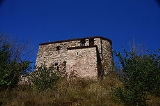
Castle of Gallifa
Encyclopedia

Gallifa
Gallifa is a municipality in the comarca of the Vallès Occidental in Catalonia, north-western Spain.-Claim to fame:The tiles for Joan Miro's ceramic mural Gallifa is a municipality in the comarca of the Vallès Occidental in Catalonia, north-western Spain.-Claim to fame:The tiles for Joan Miro's...
, a small village of Catalonia
Catalonia
Catalonia is an autonomous community in northeastern Spain, with the official status of a "nationality" of Spain. Catalonia comprises four provinces: Barcelona, Girona, Lleida, and Tarragona. Its capital and largest city is Barcelona. Catalonia covers an area of 32,114 km² and has an...
. It is a small fortification that was the historical and jurisdictional center of the village in the Middle Ages.
Description
The castle is on a 600 metres (1,968.5 ft) high hill and comprises defensive walls around a plateau with portals on the west and east side, both of them with look-out towers.History
In recent excavations IberianIberians
The Iberians were a set of peoples that Greek and Roman sources identified with that name in the eastern and southern coasts of the Iberian peninsula at least from the 6th century BC...
walls were found from the 8th century BC that indicate a stable settlement in the territory. The first documentation of the castle is from 999 CE.
Originally, the castle belonged to the count of Barcelona and was controlled by the Gallifa family, a name they adopted from the castle. They are documented from 1060 with Ramon, son of Adaltrudis, married to Rodlendis. He was followed by his son, Bernat Ramon de Gallifa, who was also a Castilian of the castle of Clarà, in Moia
Moià
Moià is a municipality of the shire of Bages....
. Bernat Ramon died about 1115 and the castle was jointly inherited by his son Ramon Bernat, who was also Castilian of Maçanet, and his daughter Rodlendis, who was married to Guillem Humbert de Rocafort. In 1348 the lord of the castle was Bernardo de Guasius de Petra. Between 1357 and 1564 it was occupied by the Centelles family. Around that time the people from Gallifa bought their freedom from taxation from King Philip II of Spain
Philip II of Spain
Philip II was King of Spain, Portugal, Naples, Sicily, and, while married to Mary I, King of England and Ireland. He was lord of the Seventeen Provinces from 1556 until 1581, holding various titles for the individual territories such as duke or count....
for 10,000 sous. The castle was no longer used as a fortress by the 16th century, and became the center of the parish of Santa Maria del Castell ("Saint Mary of the Castle").
Santa Maria del Castell
The Romanesque church of Santa Maria del Castell ("Saint Mary of the Castle") from the 11th century is built at high point inside the castle and is documented from 1060. It is a single naveNave
In Romanesque and Gothic Christian abbey, cathedral basilica and church architecture, the nave is the central approach to the high altar, the main body of the church. "Nave" was probably suggested by the keel shape of its vaulting...
plan with an apse
Apse
In architecture, the apse is a semicircular recess covered with a hemispherical vault or semi-dome...
and an upper fortified floor with an embrasure
Embrasure
In military architecture, an embrasure is the opening in a crenellation or battlement between the two raised solid portions or merlons, sometimes called a crenel or crenelle...
built by the 14th century as a last resort for the inhabitants of the castle. Until 1860 it was parish seat of part of the area, sharing this function with the church of Gallifa.
The original image of Santa Maria del Castell, dating from the 19th century, was ruined during the Spanish Civil War
Spanish Civil War
The Spanish Civil WarAlso known as The Crusade among Nationalists, the Fourth Carlist War among Carlists, and The Rebellion or Uprising among Republicans. was a major conflict fought in Spain from 17 July 1936 to 1 April 1939...
(1936-1939).
Ecological sanctuary
In 1985, the priest of Gallifa, Josep Dalmau, started the reconstruction of the Romanesque hermitage. As the hermitage had no image, the collector Jesús Prujà offered an image of a Virgin from the 11th century, which he had found in the loft of a farmhouse near OlotOlot
Olot is the capital of the comarca of the Garrotxa, in the province of Girona, Catalonia, Spain.- Etymology :The etymology of Olot is not clear and there are several hypotheses...
, acting as a buttress on the framework of the roof. The name and origin of the saint are not known. The priest Dalmau accepted it, renaming it with the dedication Mare de Déu de l´Ecologia ("Mother of God of the Ecology").
Once the church was restored, the place was converted into a meeting space for the defense of ecological values from a Christian perspective. In the perimeter of the ancient castle there is a park with several icons to the value of ecology, climbing, and mountaineering.

